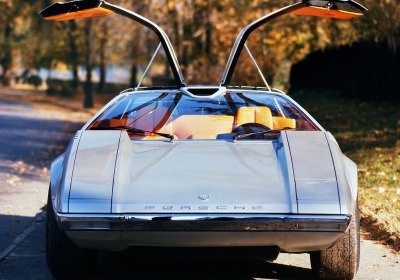Concept Car of the Week: Porsche Tapiro (1970)
Fri, 11 Jan 2013By the late 1960s it was time for Porsche to create a new car that would replace its ageing entry-level model, the 912. Its sister company Volkswagen also needed a sports coupe to replace the Karmann Ghia and so the two brands joined together to develop what would become the Porsche 914.
These days the 914 holds something of a ‘cool factor', generally considered as the ‘black sheep' in Porsche history. Underpowered and not really pretty, it is judged to be so bad that it is, in fact, good. Its quirky design, however, divided opinions when presented in 1969, and Giorgetto Giugiaro – then working at Italdesign – decided to develop his own interpretation on the project. He presented the Tapiro sports coupe concept at the Turin Motor Show in 1970.
Based on the high-end 914/6, the Tapiro shares the same platform while the air-cooled flat-6 from the donor car was enlarged from 1,990cc to 2,400cc. The 914's body was replaced with a radical wedge design that seduced both the public and the press.
The car is lower and wider by 100mm while being 80mm longer overall, with more front and less rear overhang. It is because of the combination of the long, pointy nose and the high tail that Giugiaro chose the name Tapiro (tapir), because he felt it resembled the animal.
The innovative proportions would also become a template and signature for many of his designs including the Maserati Boomerang, the Maserati Bora and the Delorean DMC-12.
From the rising belt line to the door graphics and front bumper, the car is dominated by straight lines. The Tapiro features gull wing doors and engine openings, which use a steel cross structure that carries the door hinges lengthways while acting as a roll bar.
The futuristic opening mechanism might have appeared like a concept car fantasy, but it found its way to production on the gorgeous DeTomaso Mangusta, another of Giugiaro's creations. Along the central frame are functional air vents; just above the windshield is an air intake for the passenger compartment; at the middle is the cockpit exhaust and further back are gills for engine cooling.
Inside, the theme is almost a preview of the Lotus Esprit unveiled two years later, with a linear dashboard diving towards the high center console and topped with a square speed cluster. Contrasting with the cold silver and chrome exterior, the interior – covered in warm orange leather – is an invitation to get behind the wheel.
Thanks to its Porsche platform, the car was a fully-functioning automobile and was ready to potentially move into production. The prototype was shown again at the Los Angeles Auto Expo in 1971 and was sold the following year to a Spanish industrialist, who used it as an everyday car until some of his employees bombed it during a strike. The burnt shell was repurchased by Italdesign and is now displayed in the corporate museum.
Rest in peace, Tapiro.
Designer Giorgetto Giugiaro
Length 4,060mm
Width 1,760mm
Height 1,110mm
Engine 2.4-liter flat-6
Power 220bhp
Your author, Flavien Dachet, is a UK-based, French-born car designer. You may know him as the purveyor of KarzNshit, a photo blog that if isn't already in your bookmarks, certainly should be.
By Flavien Dachet

